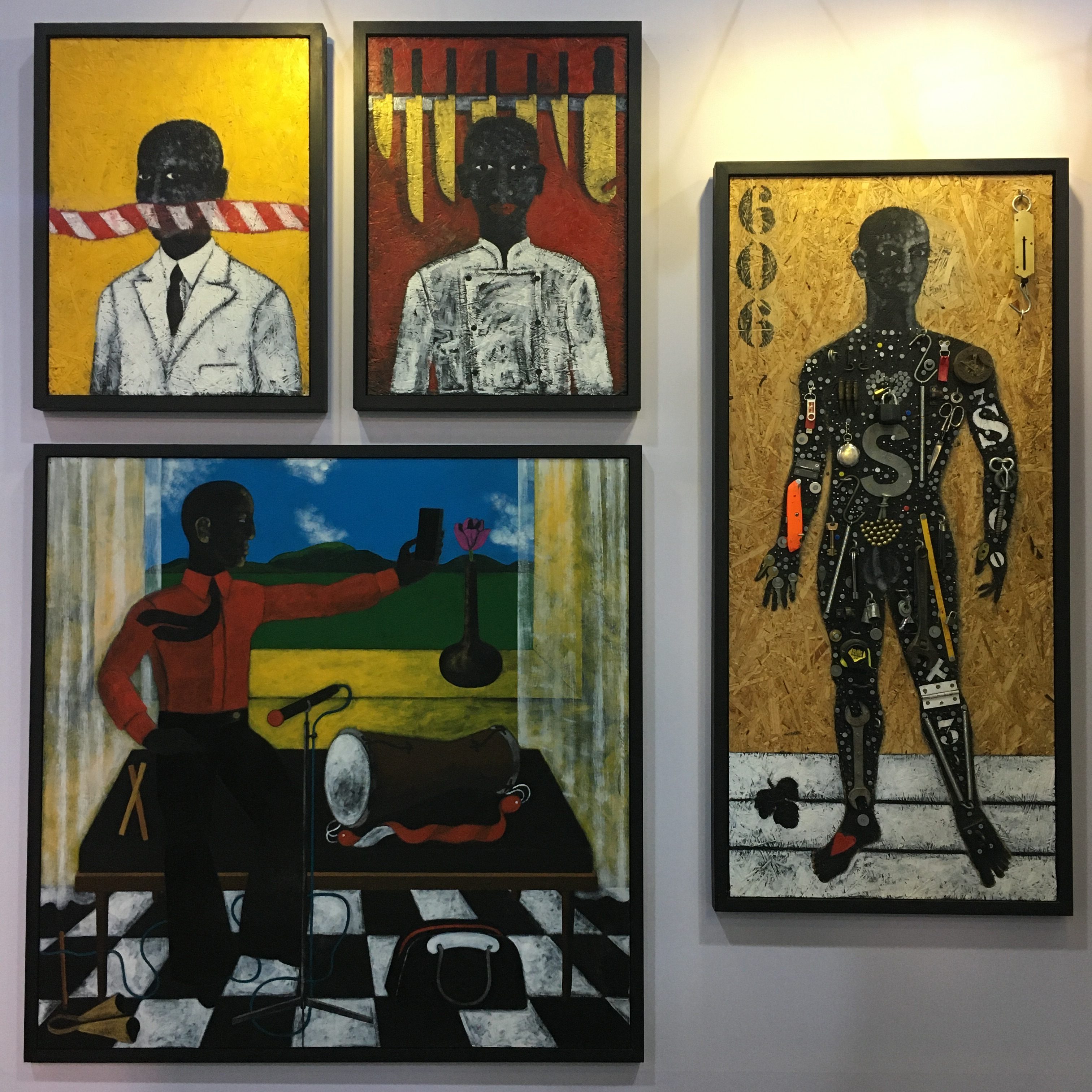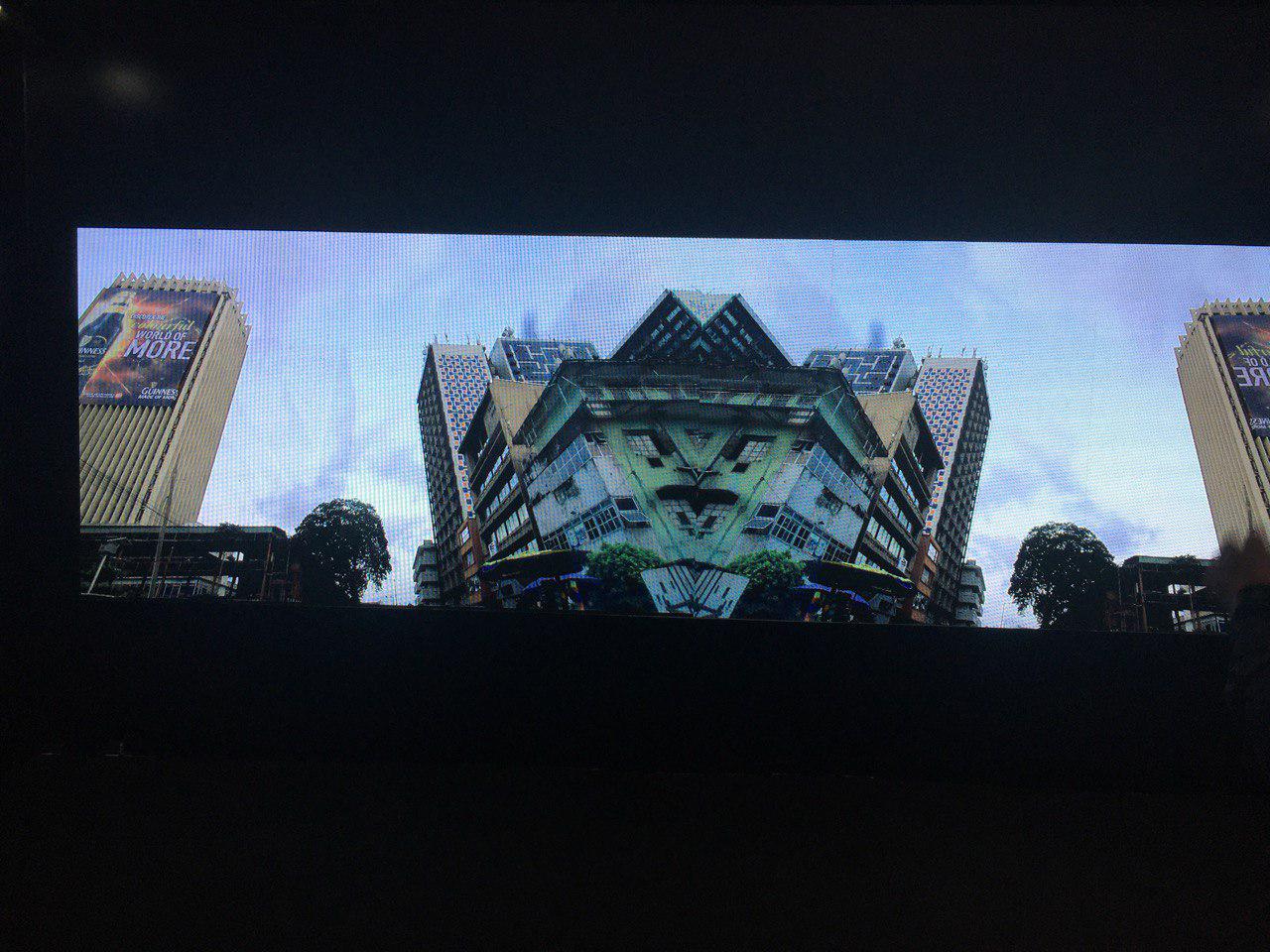adeoluwa oluwajoba reviews ART X Lagos 2019 in comparison with past editions, and possibly, what is to be expected in the future.

In his review of the 2018 edition of the ART X Lagos art fair for The Sole Adventurer Ifeoluwa Nihinlola notes, “It’s almost impossible to apprehend the discretions taken by the fair selection committee, but whatever they are, they either have to become stricter, or the fair’s organisers should start thinking of moving to a larger space”. For the 2019 edition of the fair, the organisers seem to have taken just that advice. One of the most significant changes in the fair’s structure was the choice to situate the event at the Federal Palace Hotel ー a much bigger space than the formerly used Civic Centre ー with its sprawling hall allowing for easy navigation between gallery booths and curated projects. While the commercial nature of the fair came across heavily in its presentation (as with other fairs around the world), there seemed to be a deliberate effort to cultivate a higher standard in the presentation of work shown, a much-needed improvement on the previous editions.
A first impression a viewer might get when walking through the booths is the overwhelming presence of figurative work done in traditional painting media, an indication of what is still considered saleable in contemporary art.
In the weeks leading to the event, ART X Lagos had stated in their press release, that they would be working with 23 galleries and 90 artists for the 2019 edition. In the fair catalogue however, 22 galleries with about 60 artists were documented. Still, a significant growth from previous editions, this reflects the fair’s resolve in its goal to showcase art and artists from the African continent and its diaspora with representatives from several countries, including Ghana, Uganda, Kenya, Cameroon, Ethiopia, Spain, amongst others. The fair also saw new participating galleries like Ed Cross Fine Art (United Kingdom), Everard Read (South Africa), Galerie Cécile Fakhoury (Cote d’Ivoire), Galerie Voss (Germany), and Mydrim Gallery (Nigeria).
A first impression a viewer might get when walking through the booths is the overwhelming presence of figurative work done in traditional painting media, an indication of what is still considered saleable in contemporary art. The impression a viewer might get from the gallery presentation was, to use Michael Glover’s words in his review of the Frieze Art Fair in 2017, “painting as evidence of – and a back-drop to – conspicuous consumption on the grand scale”.

In contrast to showing works from different artists in a booth, as is traditional art fair practice, Ed Cross Fine Art held a solo presentation of London-based Nigerian artist Abe Odedina which invited the viewers into the expressive and allegorical world of the artist inspired by the figurative and oral traditions of African art. His deeply evocative portraits situate black bodies in normal, every day and sometimes allegorical context which help place his work outside of the limitations of race-conscious work. The minimalist and enigmatic works of US-based Nigerian artist ruby onyinyechi amanze shown at Tiwani Contemporary seemed intent on pushing the boundaries of traditional notions of image-making and composition. Her works which featured birds in several positions of flight within a constructed environment raises questions concerning the dynamics of movement within built space.
Probably one of the most impressive presentations at the fair, Peju Alatise’s large-scale installation at Arthouse Contemporary explores her broad interest in experimenting with materials and techniques in engaging various socio-political issues.
Particularly exciting was SMO Contemporary’s presentation of work by Nigerian artists; Data Oruwari, whose intricately detailed Afro-futuristic drawings explores spirituality and the divine from an African perspective, Emeka Udemba’s mixed-media portraits which explore the notions of identity, especially in relation to the constructed ‘Other’ in the society, and Ngozi Omeje whose ceramic installations involve using globular clay units suspended from strings to reproduce unique and often complex forms. The booth also featured paintings by Beninoise artist Moufouli Bello done predominantly in blue which features intimate and often arresting portraits of women in various states of repose. With the meticulous arrangement, detailed information about the works shown and the availability of an e-catalogue that viewers can engage with long after the fair is over, SMO’s presentation felt more like an exhibition and less like a fair.

Probably one of the most impressive presentations at the fair, Peju Alatise’s large-scale installation at Arthouse Contemporary explores her broad interest in experimenting with materials and techniques in engaging various socio-political issues. The formidable installation titled One side of the coin, not born to suffer. Here I present to you- living the sheltered life. featured winged female figures suspended in circular structures amid light bulbs that helped to offset the prevalent two-dimensional quality of the fair.
An interesting highlight in the fair’s programming was ART X Modern, a series of booths dedicated to showing work by African modern artists. The booths presented by three galleries featured works by prominent modern artists from Nigeria and Ghana including Ben Enwonwu, Ablade Glover, Uche Okeke and Demas Nwoko. The presentation by Mydrim Gallery introduced viewers to the lesser-known realistic sculptural portraits by Abayomi Barber. Uche Okeke and Obiora Udechukwu’s seminal experiments with form, line and preoccupation with the Uli design were on view at Bloom Art. Their works brought to mind the early concerns of Nigerian modernist artists—merging traditional art imagery with Western art practices. Ablade Glover’s work presented by Gallery 1957 showcased familiar works done in his signature impasto style which reference and celebrate the bustling and boisterous energy found in the people and landscape of major cities across the continent. However, considering that the presentation, according to ART X Lagos founder and director Tokini Peterside, was “dedicated to Africa’s modern art pioneers”, the exclusion of other notable figures of African modernism left a little to be desired.

Despite the unapologetically commercial nature of the fair’s thrust, this year’s edition saw a further exploration of new, experimental and traditionally non-commercial works in form of sound installations, virtual reality, augmented reality and performance. There seemed to be a concerted effort on the part of the organisers to counter, or at the very least, reduce the notion of commerciality traditionally associated with art fairs. This effort is best seen in the selection of this year’s keynote exhibiting artist Emeka Ogboh whose primary artistic preoccupation involves working with sound, video and photography in investigating and engaging the historical, economic and social infrastructure of cities, especially Lagos. His specially commissioned project for the fair Lagos: 20Hz – 20kHz combined music with recordings from the city of Lagos. However, at this point, the fair’s commercial nature becomes present again as visitors were required to ‘rent’ wireless headphones to participate in the experience.

Aimed at “highlighting some of today’s most experimental mediums and showcasing some of the multidisciplinary artists working in them”, the curated projects at the fair added a multi-disciplinary quality to the presentation which might not be readily found in gallery booths considering the fact that a large percentage of works shown in the booth were either paintings or sculptures. From the augmented reality works of Amanda Iheme, Ifebusola Shotunde and Nyancho NwaNri which engaged with the built environment in Lagos, to the fair’s first ever Performance Pavilion which featured performances by Ngozi Schommers, Taiwo Aiyedogbon and Eca Eps, to a virtual reality film by Joel Benson which documents his studio visit with renowned Nigerian artist and architect, Demas Nwoko, the curated projects helped to introduce the general public to alternative modes of art-making and presentation. In exploring alternative ways of engagement between the audience and the fair, the Interactive Projects featured centred around the concept of ‘play’ and invited the audience to participate in the interrogation of the analogue world and a desired digital future. It also had members of the audience engaged in the creative process of fabric design exploring methods like indigo dyeing, wax and silk printing.
Its evolution may have just begun. Yet, for all its programming, curated events and the evident quality of the presentations, ART X Lagos remains just another art fair, a marketplace for the highest level of art commodification and consumerism.
The fair came to a climax on the last day with the final session of the ART X Talks devoted to the remembrance of independent curator and founder of the Centre for Contemporary Art Lagos, Bisi Silva who was the art director for the inaugural edition of ART X Lagos. The sessions included talks by curators N’Goné Fall and Antawan Bryd, and artist Emeka Ogboh reflect on the life and career of the late curator and her commitment to nurturing future generations of curators and visual artists. It was indeed a fitting end to the fair.
A long way from its first edition in terms of scale and programming, ART X Lagos is certainly positioning itself as a force to be reckoned with. The review of the fair last year ends with the note, “there is a chance that the fair has arrived at its final form, for better or worse”. This may have been a hasty conclusion. Its evolution may have just begun. Yet, for all its programming, curated events and the evident quality of presentations, ART X Lagos remains just another art fair, a marketplace for the highest level of art commodification and consumerism.





May I ask which other art fairs you have actually attended please? It would be great to have an objective comparison with other leading African art fairs such as 1:54, FNB joburg, AKAA, Cape Town art fair.
May I ask which other art fairs you have attended please? This point about commercialism and “just being like any other art fair” is very interesting. So for those of us confined to Nigeria with little to no exposure about other art fairs, an objective comparison would be helpful. For example how does Art x Lagos compete with AKAA, 1:54, FNB Joburg, Cape Town art fair etc. Thanks!